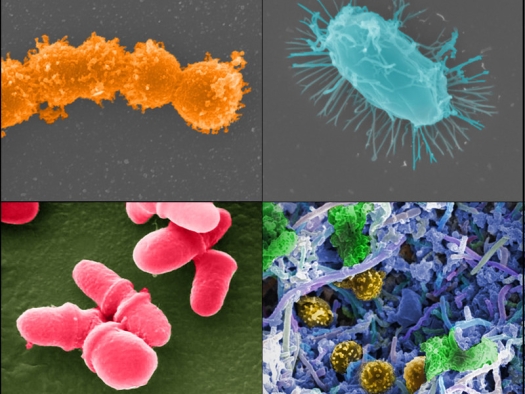HumanMicrobiomeProject.jpg

Composite image by Jonathan Bailey, National Human Genome Research Institute, NIH via Flickr / CC BY-NC 2.0
The Human Microbiome Project, which was launched by NIH in 2007, provided the first glimpse of the microbial diversity of healthy humans and is exploring the possible relationships between particular human diseases and the microbiome.
Top left: Streptococcus (Credit: Tom Schmidt); top right: microbial biofilm of mixed species, from human body (Credit: A. Earl, Broad Institute/MIT); bottom right: Bacillus (Credit: Tom Schmidt); bottom left: Malassezia lopophilis (Credit: J.H. Carr, CDC).
Five human microbiomes
You’ve heard of the gut microbiome, right?
It’s those trillions of microorganisms inhabiting the gut that keep our digestion and immune systems happy. But guess what? That’s not the only microbiome in the human body!
We actually have 5 microbiomes:
- Gut
- Skin
- Oral
- Vaginal
- Respiratory
Each of these has their own distinct composition of microorganisms to keep us healthy and balanced. And that means that all of these systems can be affected by things we do to support or disrupt our microbiome.
Functions of the microbiome
Stop ignoring your microbiome. One of the most common root causes of health issues is a disruption of the gut microbiome. That’s because the tiny microorganisms inhabiting your gut are responsible for massively important functions, including:
- Nutrient Synthesis: Bacteria in the gut produce B vitamins, vitamin K, and the healthy fatty acid, conjugated linoleic acid (CLA).
- Digestion: Certain bacteria support the digestion of fats as well as polyphenols from the diet.
- Detoxification: Specific gut microbiomes are known to metabolize some drugs and xenobiotics (toxic chemicals).
- Neurotransmitter Production: Gut bacteria directly produce neurotransmitters, including dopamine and norepinephrine.
- Immune Function: Bacteria interact with the gut-associated lymphoid tissue (GALT) to support immune function.
When we disrupt the gut microbiome, we potentially impact all of these things.
What is dysbiosis?
For anyone struggling with an unexplained health issue this is commonly missed. Dysbiosis is defined as an imbalance of the gut microbiome.
Whereas a healthy microbiome has a wide diversity of beneficial bacteria, dysbiosis can occur when any of these 3 things happen:
- Loss of beneficial bacteria
- Overgrowth of potentially harmful bacteria
- Loss of overall bacterial diversity
These 3 things can also happen simultaneously.
Research shows that disruptions of the gut microbiome are associated with conditions that affect digestion, metabolism, weight, blood sugar, and even neurological health.
How do we know if this is an issue?
We test.
Functional medicine tests such as the organic acids test and digestive stool analysis can give insights into the health of your microbiome and guide in creating a plan.
Signs of microbiome imbalance
Signs of microbiome imbalance are usually easy to identify. Changes in the balance of microorganisms in the gut (also called dysbiosis) can lead to these gut-related issues:
- Gas
- Bloating
- Smelly Stools
- Loose Stools
- Constipation
- Bad Breath
Or these systemic issues:
- Brain Fog
- Skin Rashes
- Anxiousness
- Fatigue
- Aching Joints
This is not an exhaustive list, and every person is unique!
The good news is the microbiome can be corrected, protected, and supported with functional medicine. The key is to test and then create an individualized plan.
Things that disrupt the microbiome
Check out this list.
If you want to support your digestion, immune system, metabolism, and brain, you’re going to need to have your gut microbiome on board.
So it’s important to avoid (or at least minimize) exposure to the things that most directly disrupt microbiome balance.
These include:
- Antibiotics
- Glyphosate (an herbicide residue on conventionally grown foods)
- Artificial Sweeteners
- Processed Foods
- Stress!!
There are also plenty of things you can do to support a healthy microbiome, such as eating a variety of plant foods and exercising outdoors. It’s all about tipping the scales in favor of health.
Microbiome and disease
When it comes to the microbiome, the stakes are high. We don’t see it, we can’t feel it, and yet it has power over nearly every aspect of our health.
Those trillions of microorganisms on and in us influence digestion, detoxification, immune function, brain health, and more.
Evidence-based research (PMID: 34584224) shows that changes in the gut microbiome have been associated with all of these conditions:
- Rheumatoid Arthritis
- Type 1 Diabetes
- Type 2 Diabetes
- Eczema
- Asthma
- IBD
- IBS
- Fatty Liver
- Cardiovascular Disease
- Chronic Kidney Disease
- Mental Health Disorders
The microbiome is not the only contributing factor to these conditions, but it is one that is often overlooked. And it is one that is always considered from a functional perspective.
In functional medicine, more than a diagnosis is treated. Underlying causes are considered to optimize the structure and function of all body systems.
Holistic Health Tips
Habits for microbiome health
There are several simple ways to support your microbiome. It’s easy to forget about your gut microbiome, but there are also easy ways you can support microbial diversity with everyday habits, such as:
- Microbiome-Friendly Foods: The Mediterranean Diet, fermented foods, fiber-rich foods, and polyphenols (colorful compounds in plant foods) have all been found to benefit the microbiome.
- Regular Exercise: Exercise (as long as it is not training to exhaustion) benefits the diversity of the gut microbiome.
- Sleep & Circadian Rhythm: Unnatural disruptions in the sleep-wake cycle or short duration of sleep may alter the gut microbiome and intestinal health.
The benefit of doing these things?
Better digestion, stronger immune system, healthier metabolism, sharper brain function, and overall wellness.
Gut-skin axis
Want clear and glowing skin? Not many people realize this, but your skin has an ecosystem of its own (the skin microbiome), which can be nurtured or harmed just like the gut microbiome.
Studies have shown that the composition of bacteria on your skin directly correlates with skin hydration and texture, which in turn affect how your skin looks and feels. You can support your skin microbiome from the outside (by what you put on it) and the inside (through the gut-skin axis!).
For example:
- Use gentle skincare products rather than harsh and alcohol-based products.
- Eat a microbiome-friendly diet, rich in antioxidants, fiber, and probiotic-rich foods.
- Work with a practitioner to identify the root cause of any skin concerns you have.
Microbiome and metabolism
Here’s how your gut microbiome affects metabolism (and why to fix it!):
- Glucose Metabolism: An altered gut microbiome can increase the amount of insulin released in response to blood glucose, a pattern associated with insulin resistance.
- Ghrelin Production: An altered gut microbiome can increase the secretion of ghrelin, a hormone that signals the brain it is hungry.
- Calorie Uptake: The composition of microbiota associated with obesity increases the absorption of calories from ingested foods.
What does this mean? It means that there is more to metabolic health and weight loss than just counting calories and exercising. Functional medicine looks at correcting the metabolism from a whole person perspective, including gut health and the microbiome.
Microbiome diversity
Save this post!
You’ll want to come back to it whenever your microbiome needs a reset – especially when you want to rebuild microbial diversity.
Top tips:
- Consume probiotic-rich foods or drinks, like yogurt, kefir, kombucha, and sauerkraut.
- Increase prebiotic-rich foods, like artichokes, asparagus, onions, and bananas.
- Focus on diversity in your diet, emphasizing colorful whole foods rather than processed ones.
- Stay hydrated with water and tea, keeping alcohol to a minimum.
- Exercise at least 30 minutes a day at least 3 days a week.
- Follow a regular sleep schedule for a healthy circadian rhythm.
And remember: You are unique!
If you feel like you are doing everything “right” but still struggle with gut health, contact a functional medicine doctor. A list of practitioners is available at the Institute for Functional Medicine website.
Fermented foods
Just because fermented foods and probiotics are promoted far and wide for gut health does not mean they are for everyone!
- Some people already have an overgrowth of beneficial bacteria.
- Some people have inflammation, sensitivities, and compromised digestion.
- Some people need to do some healing before being able to handle these foods.
What’s best for you depends upon the composition of your unique microbiome at this moment. That’s why, if you’re struggling with gut health, it’s so important to work with a qualified practitioner on a personalized plan.
Mouth breathing and microbiome
Do you tend to breathe more through your mouth or your nose?
Your mouth has a microbiome of its own, but did you know that the oral microbiome depends on how you breathe? A study of children found that mouth breathing had an adverse effect on the oral microbiome by increasing the number of pathogenic (bad) bacteria in the mouth.
Here are 5 ways to support a healthy oral microbiome:
- Nasal (rather than mouth) Breathing
- Tongue scraping
- Flossing
- Replacing toothbrush heads regularly
- Avoiding antiseptic mouthwash
Optimizing the oral microbiome can support the health of your teeth, gums, and digestion.
References
- Gupta VK, Paul S, Dutta C. Geography, Ethnicity or Subsistence-Specific Variations in Human Microbiome Composition and Diversity. Front Microbiol. 2017;8:1162. Published 2017 Jun 23.
- Jandhyala SM, Talukdar R, Subramanyam C, Vuyyuru H, Sasikala M, Nageshwar Reddy D. Role of the normal gut microbiota. World J Gastroenterol. 2015;21(29):8787-8803.
- Strandwitz P. Neurotransmitter modulation by the gut microbiota. Brain Res. 2018;1693(Pt B):128-133.
- DeGruttola AK, Low D, Mizoguchi A, Mizoguchi E. Current Understanding of Dysbiosis in Disease in Human and Animal Models. Inflamm Bowel Dis. 2016;22(5):1137-1150.
- Ahmad SY, Friel J, Mackay D. The Effects of Non-Nutritive Artificial Sweeteners, Aspartame and Sucralose, on the Gut Microbiome in Healthy Adults: Secondary Outcomes of a Randomized Double-Blinded Crossover Clinical Trial. Nutrients. 2020;12(11):3408.
- Beurel E. Stress in the microbiome-immune crosstalk. Gut Microbes. 2024;16(1):2327409.
- Juul F, Vaidean G, Parekh N. Ultra-processed Foods and Cardiovascular Diseases: Potential Mechanisms of Action. Adv Nutr. 2021;12(5):1673-1680.
- Patangia DV, Anthony Ryan C, Dempsey E, Paul Ross R, Stanton C. Impact of antibiotics on the human microbiome and consequences for host health. Microbiologyopen. 2022;11(1):e1260.
- Walsh L, Hill C, Ross RP. Impact of glyphosate (RoundupTM) on the composition and functionality of the gut microbiome. Gut Microbes. 2023;15(2):2263935.
- Vijay A, Valdes AM. Role of the gut microbiome in chronic diseases: a narrative review. Eur J Clin Nutr. 2022;76(4):489-501
- Berding K, Vlckova K, Marx W, et al. Diet and the Microbiota-Gut-Brain Axis: Sowing the Seeds of Good Mental Health. Adv Nutr. 2021;12(4):1239-1285.
- Matenchuk BA, Mandhane PJ, Kozyrskyj AL. Sleep, circadian rhythm, and gut microbiota. Sleep Med Rev. 2020;53:101340.
- Ticinesi A, Lauretani F, Tana C, Nouvenne A, Ridolo E, Meschi T. Exercise and immune system as modulators of intestinal microbiome: implications for the gut-muscle axis hypothesis. Exerc Immunol Rev. 2019;25:84-95.
- Hwang BK, Lee S, Myoung J, et al. Effect of the skincare product on facial skin microbial structure and biophysical parameters: A pilot study. Microbiologyopen. 2021;10(5):e1236.
- Gao T, Wang X, Li Y, Ren F. The Role of Probiotics in Skin Health and Related Gut-Skin Axis: A Review. Nutrients. 2023;15(14):3123. Published 2023 Jul 13.
- Asadi A, Shadab Mehr N, Mohamadi MH, et al. Obesity and gut-microbiota-brain axis: A narrative review. J Clin Lab Anal. 2022;36(5):e24420.
- Fan C, Guo L, Gu H, Huo Y, Lin H. Alterations in Oral-Nasal-Pharyngeal Microbiota and Salivary Proteins in Mouth-Breathing Children. Front Microbiol. 2020;11:575550. Published 2020 Oct 9.
- Tribble GD, Angelov N, Weltman R, et al. Frequency of Tongue Cleaning Impacts the Human Tongue Microbiome Composition and Enterosalivary Circulation of Nitrate. Front Cell Infect Microbiol. 2019;9:39. Published 2019 Mar 1.
Revised by Joanne Quinn, PhD; content provided by Wellnesswriter.com.


